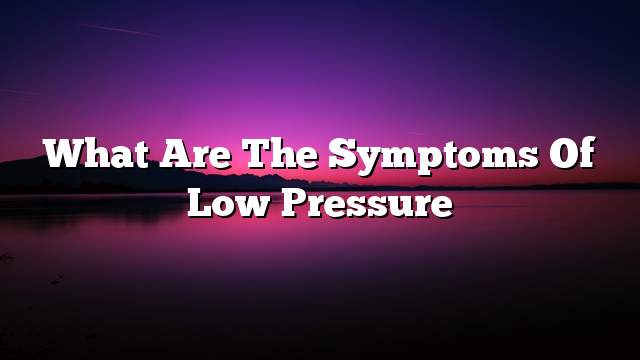Reduction of Blood pressure
Blood pressure expresses the force in which blood affects the walls of blood vessels when the heart pumps it all over the body. Blood pressure readings consist of two readings, the highest expressing systolic blood pressure, ie, at the moment the blood is pumped into the heart, and the lower reading of the diastolic blood pressure, ie when the heart muscle relaxes Between the pulses. The normal blood pressure in adults is less than 120/80 mm Hg. Hypotension is known as a 90/60 mmHg reduction in pressure reading. This decrease is due to many causes, and may be normal for some people. What needs attention in case of low pressure is the patient’s feeling of any symptoms , Then you should go to the doctor to find out why this drop.
Symptoms of low blood pressure
Hypertension may be normal in some people and does not cause any symptoms. In some patients, it may indicate a particular problem, especially if there is a sudden drop in blood pressure, or if accompanied by a feeling of symptoms. These symptoms appear as a result of reduced blood flow to the body organs, and the symptoms vary depending on the affected member. Symptoms of low blood pressure include:
- Feeling dizziness or dizziness.
- Suffering from fainting.
- Feeling tired overall.
- Suffering from shortness of breath, and may be accompanied by a feeling of pain in the chest.
- Feeling nauseous.
- Loss of focus.
A severe drop in blood pressure may cause the patient to enter a shock condition that may pose a risk to his life. The patient may have several symptoms, including:
- Confusion, especially in older people.
- Pale skin color and coolness.
- Acceleration and weak heartbeat.
- Breathing fast and shallow.
Causes of low blood pressure
Causes of hypotension vary, and it is necessary to detect this cause for proper treatment. The main causes of hypotension are as follows:
- Pregnancy: The pregnant woman may suffer from low pressure during pregnancy, but the pressure readings return to pre-pregnancy. This is due to the rapid expansion of the circulatory system in the body during pregnancy.
- Heart Disease: Such as slow heart rate (Bradycardia), heart valve disease, heart attack, and heart failure.
- Endocrine Diseases: Such as thyroid disease, adrenal insufficiency, low blood sugar, and diabetes as well.
- Drought: This occurs when the body loses fluids through high body temperature, vomiting, severe diarrhea, excessive use of diuretics, or as a result of a great physical effort.
- Bleeding: Loss of blood leads to lower pressure, such as when a large wound or internal bleeding occurs.
- Suffering from sepsis: Septicemia occurs when an infection has reached the bloodstream, causing high blood pressure. Septic shock is called septic shock.
- Severe allergic reaction: Anaphylaxis is a serious condition caused by exposure to allergens, such as taking certain medications, foods, exposure to insect toxins and others.
- Anemia: Anemia may be caused by the lack of certain substances necessary to make red blood cells, such as vitamin B12 and folic acid.
Treatment of low blood pressure
If there is no cause for hypotension, there is no need for any treatment. The most important ways to treat low blood pressure are as follows:
- Treatment of low blood pressure: Here are different methods of treatment depending on the cause, and these methods of treatment are:
- Antibiotics if infection is the cause of low blood pressure.
- Adrenaline plus antihistamine is given if blood pressure is the result of an allergic reaction.
- Blood transfusion in bleeding.
- General procedures for treating low blood pressure: These procedures are used in the absence of a clear cause of low blood pressure, or lack of treatment. These procedures aim to raise blood pressure and thus reduce the symptoms and signs resulting from it. These include the following:
- Too much salt in the diet, sodium in it works to raise blood pressure, but it is necessary to consult your doctor before doing so for the association of large amounts of salt with heart disease.
- Take large amounts of water to increase blood volume and prevent dehydration.
- Wear compression socks that prevent blood circulation in the legs and are commonly used in the treatment of varicose veins.
- Take some medications, such as fluorocortisone, which increases blood volume, and medodrine (Medodrine), which prevents blood vessels from expanding. These drugs are used in the treatment of orthostatic hypotension.
